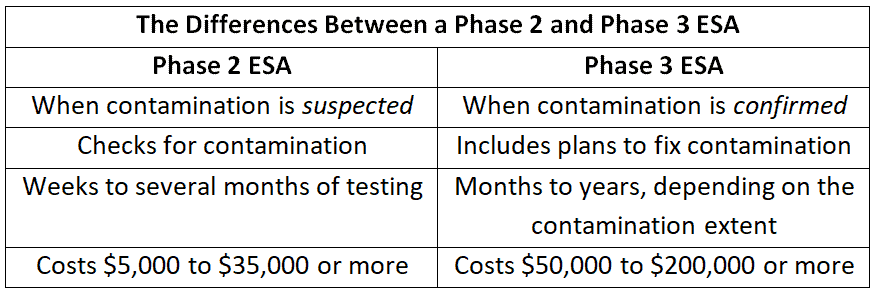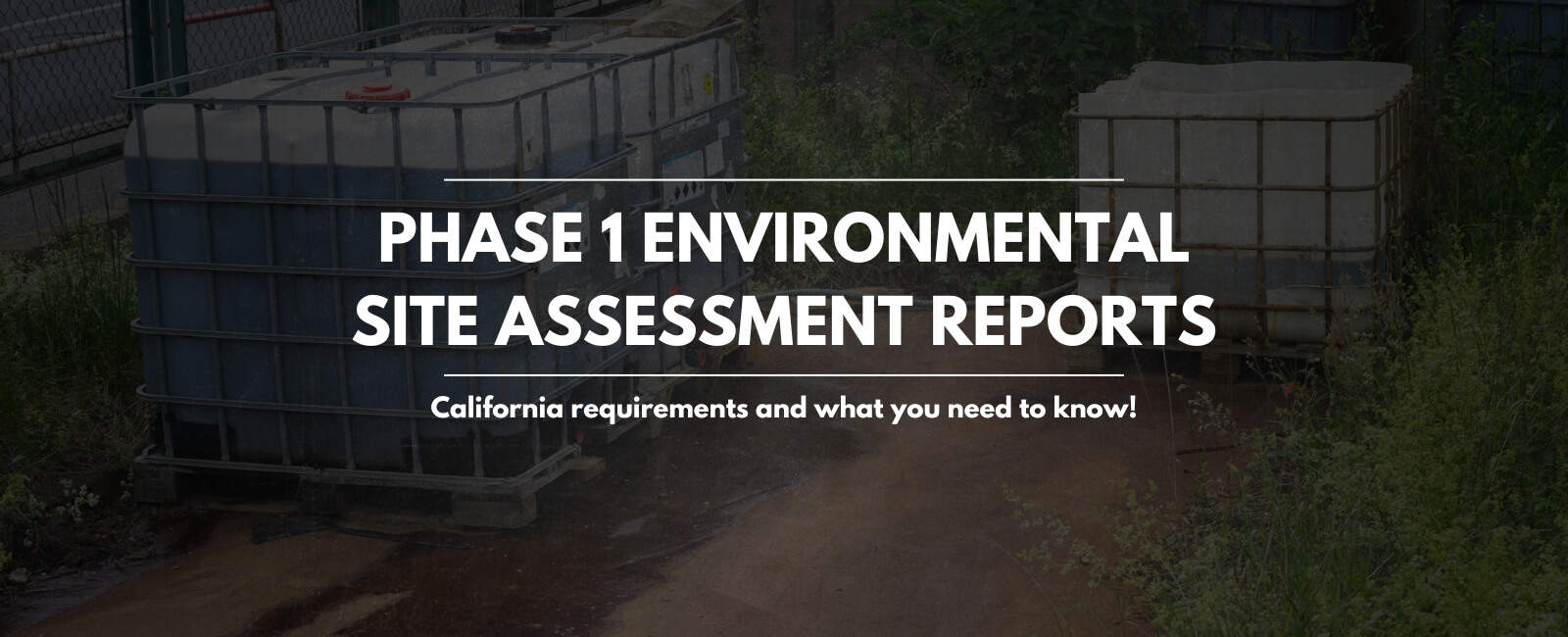Inexperienced commercial real estate brokers don’t put much thought into Phase 1 Environmental Site Assessment (ESA) reports.
Conversely, a broker who has been in the game for years knows they’re crucial for most transactions.
You see, banks are involved in most commercial real estate deals, and they won’t approve a transaction without a Phase 1 report.
A “No Further Action” result is essentially a stamp of approval from an environmental company that gives lending institutions the confidence to move forward with the deal.
However, these reports are much more complex and subjective than you’d expect.
Here, you’ll learn all you need to know about Phase 1 and Phase 2 ESA reports and how we can help you find trustworthy environmental firms that won’t unnecessarily suggest a Phase 2 just to boost their profits.
What Is a Phase 1 Environmental Site Assessment (ESA) Report?
A Phase 1 Environmental Site Assessment (ESA) report gauges whether past or present property uses have affected the soil or groundwater.
The goal is to identify potential environmental and public safety risks that may become liabilities for lenders and property owners.
Here’s the key information you need to know about Phase 1 ESA reports:
- They’re required for the transaction of all types of commercial and industrial properties and land.
- They fulfill CERCLA requirements.
- Buyers pay for these reports during the escrow period, not sellers.
However, if issues are detected, a Phase 2 report is required. These reports are expensive and paid for by the seller. It may also lead to property devaluation and other consequences — more on this later.
Despite following established guidelines such as the ASTM E1527-13, Phase 1 reports can be quite subjective. Some environmental companies suggest a Phase 2 just to make more money.
You need to choose an honest company that won’t turn a small issue into a time-consuming and expensive Phase 2 report.
We can connect you with the trustworthy firms we’ve been working with for years. If you need help getting your commercial property assessed, don’t hesitate to give us a call at 818.482.3830.
In addition, most banks have a list of environmental firms to choose from. We can help you qualify buyers for your commercial property by learning which bank they’re working with, and advising you on whether their list of companies is trustworthy.
What Is Involved in a Phase 1 Environmental Assessment?
A Phase 1 Environmental Assessment involves:
- Visiting the site to assess property conditions and uses
- Reviewing federal, state, local, and tribal databases, including the Underground Storage Tank (UST) Database
- Examining historical records such as topographic maps, city directories, and aerial photographs
- Interviewing property stakeholders, including past and current owners and occupants
- Reviewing title and judicial records for environmental liens
Phase 1 ESA Reports and Underground Storage Tanks (USTs)
Checking the Underground Storage Tank (UST) Database is a key part of a Phase 1 ESA.
Decades ago, the property might have been a gas station with diesel and gasoline tanks or agricultural land with pesticide tanks, for example.
Environmental professionals (EPs) browse the database for records of USTs on the property and check their compliance status, inspection records, and any reported incidents or releases of hazardous substances.
Records of underground tanks are one of the main reasons a Phase 2 report is suggested. In these cases, the tanks need to be removed from the ground, and the soil has to be tested for leaked contaminants.
If you’re selling your commercial property, we can connect you with the UST removal expert we work with if needed. Reach us at 818.482.3830 or [email protected].
How Long Does a Phase 1 ESA Take?
The time it takes to carry out a Phase 1 ESA depends on:
- The property’s development history and complexity
- The thoroughness of the investigation
- The availability of information
- Additional requirements based on the findings
On average, it takes two to four weeks to complete a Phase 1 ESA, but it can take up to three months. You can pay extra to get it expedited.
How Much Does a Phase 1 Environmental Site Assessment Cost in California?
In California, a Phase 1 Environmental Site Assessment costs between $1,800 and $4,600, depending on the property’s location and the complexity of its history and uses.
These reports identify risks, but they’re only the first step. The cost may increase if soil, water, lithological, and radon testing or lab analysis are required.
In addition, if there’s a strong reason to believe contamination has occurred, the property can’t be sold without completing a Phase 2 ESA, which is significantly more expensive than a Phase 1 and paid by the seller.
As mentioned above, some companies unnecessarily request a Phase 2 just to make more money. It’s crucial to vet buyers and pick trustworthy environmental companies like the ones we work with.
Give us a call at 818.482.3830 or send us an email at [email protected] if you’re selling your commercial property — we can connect you with one of our trusted vendors.
What Are the Outcomes of a Phase 1 ESA?
A Phase 1 ESA report summarizes the environmental company’s findings and typically results in one of these outcomes:
- “No RECs” if no significant environmental concerns are identified.
- “RECs Identified” if potential environmental issues that warrant further assessment or action are identified.
- “No Further Action” if the property is deemed suitable for the intended use without the need for additional investigation or remediation.
- “Recommendation for a Phase 2 ESA” if signs of possible contamination, the existence of hazardous substances, or a recognized environmental condition are identified.
The goal of every party in a transaction — the buyer, seller, and commercial property broker — is to get a “No Further Action” result on the Phase 1 report.
This means we can move the deal forward. It’s essentially a stamp of approval from the environmental firm that gives lending institutions the confidence to move forward with the deal.
What Are Recognized Environmental Conditions (RECs)?
Recognized Environmental Conditions, or RECs, are conditions identified during a Phase 1 ESA that suggest the potential presence of hazardous substances or contamination on a property.
If RECs are identified, further investigation or remediation may be needed — but they don’t always require a Phase 2. Sometimes, they can be managed in other ways.
Again, this is why it’s so important to work with a decent environmental company that puts your interests ahead of profit.
Our trusted vendors include ODIC Environmental and (QA) 2 Environmental, who we’ve been working with for years.
We can connect you with them and guide you through the process of getting your commercial property assessed before selling it. Give us a call at 818.482.3830.
What to Do if a Phase 2 ESA Is Suggested
Phase 2 ESA reports can cost over $35,000 and are paid by the seller.
Having an experienced commercial real estate broker on your side can make a world of difference if a Phase 2 is suggested.
This is because the results of a Phase 1 can potentially be challenged.
When our clients get a “Recommendation for a Phase 2 ESA” result, we ask the bank if it’s possible to have our preferred environmental company do a peer review and offer their input.
Although it doesn’t always work, it’s a possible solution as long as the lending institution approves our request.
After reviewing the first Phase 1 report, the firm tells us whether they can give us a “No Further Action.” If so, we move forward with a second Phase 1 ESA.
For example, at the time of writing, we’re in escrow on an industrial property in Pacoima, CA. Before signing the listing agreement to sell the property, our client got a Phase 1 from an environmental company without our knowledge.
The company suggested a Phase 2 due to suspected PCE and VOC contamination, which resulted in long delays and the bank not approving the deal.
We got one of our partner environmental firms to do a peer review. They found that the degree of contamination was within the acceptable threshold — and that it had happened in the mid-1900s when a large-scale aircraft facility was on the property.
In reality, most lots have had some level of contamination — a Phase 2 is an overreaction in many cases.
In the end, our partners found that the contamination was below screening levels and gave us a “No Further Action” result that allowed us to quickly move the process forward.
What Is a Phase 2 Environmental Site Assessment? How Is It Different From a Phase 1?
If certain environmental issues are identified, a Phase 2 Environmental Site Assessment is needed after a Phase 1.

A Phase 2 ESA involves on-site sampling and laboratory testing of soil, groundwater, or soil vapor.
The goal is to confirm the presence, extent, and nature of contamination and provide detailed data. It also helps in deciding on remediation measures if needed.
How Much Does a Phase 2 Environmental Site Assessment Cost in California?
Usually, a Phase 2 Environmental Site Assessment costs between $5,000 and $35,000, but it can cost more depending on the severity of contamination and the scope of assessments and remediation required.
The seller is expected to pay for these reports. However, they’re often so expensive that the deal ends up being canceled because neither the seller nor the buyer wants to pay for it.
If the results of the Phase 1 report on your commercial real estate property suggest a costly Phase 2 ESA, call us at 818.482.3830.
We’ll connect you with trustworthy environmental companies that can peer review and potentially challenge the results.
What Is the Difference Between Phase 2 and Phase 3 ESA Reports?
If the Phase 2 report confirms your property is contaminated, a Phase 3 ESA is needed.
It’s known as the remediation phase since it involves plans to fix contamination.

Both of these reports are expected to be paid by the seller.
Key Takeaways: Where Can I Get a Phase 1 Environmental Site Assessment in California?
There are loads of environmental companies in California that conduct Phase 1 ESA reports on commercial properties.
However, a lot of them try to make up for their high overhead costs by suggesting unnecessary, expensive Phase 2 reports.
That’s why it’s so important to work with an experienced commercial real estate broker who can connect you with tried-and-tested, honest environmental firms.
Our seasoned team of brokers can help you navigate every step of your commercial property sale and refer you to our network of trusted vendors, ensuring a smooth process from start to finish.
Reach us via our contact form, email us at [email protected], or call 818.482.3830 today to get the ball rolling on your commercial property sale.
MIG Commercial Real Estate Services Inc. and Alex Matevosian do not provide legal, tax, or investment advice. Any published articles, blog posts, resources, or other related material located on this website are for information purposes only. Please seek the advice of an attorney, tax professional, and/or financial advisor for legal, tax, or financial advice.

